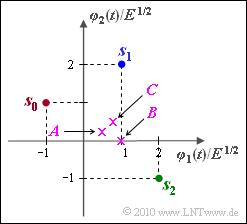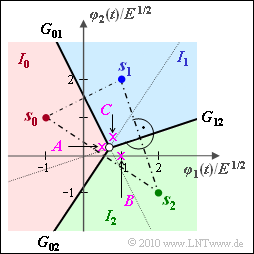Difference between revisions of "Aufgaben:Exercise 4.08: Decision Regions at Three Symbols"
| (One intermediate revision by one other user not shown) | |||
| Line 23: | Line 23: | ||
\boldsymbol{ C } = (0.75, \hspace{0.1cm}0.50)$$ | \boldsymbol{ C } = (0.75, \hspace{0.1cm}0.50)$$ | ||
| − | + | are drawn,nbsp; each of which is to be assigned to a region $I_i$ in subtask '''(5)'''. | |
| Line 93: | Line 93: | ||
| − | '''(4)''' The graph already shows | + | '''(4)''' The graph already shows the correct answer ⇒ <u>YES</u>. |
*The intersection of $G_{\rm 01}$ and $G_{\rm 12}$ (white circle) is at $(9/14,\ 3/14)$, because of | *The intersection of $G_{\rm 01}$ and $G_{\rm 12}$ (white circle) is at $(9/14,\ 3/14)$, because of | ||
:$${3}/{2} - 2 x = {x}/{3} \hspace{0.3cm}\Rightarrow \hspace{0.3cm} | :$${3}/{2} - 2 x = {x}/{3} \hspace{0.3cm}\Rightarrow \hspace{0.3cm} | ||
Latest revision as of 12:56, 3 September 2022
We consider a signal space constellation in the two-dimensional space $(N = 2)$ with the signal set:
- $$\boldsymbol{ s }_0 = (-1, 1)\hspace{0.05cm}, \hspace{0.2cm} \boldsymbol{ s }_1 = (1, 2)\hspace{0.05cm}, \hspace{0.2cm} \boldsymbol{ s }_2 = (2, -1)\hspace{0.05cm},$$
in each case referred to the normalization value $\sqrt {E}$.
The decision regions $I_0$, $I_1$ and $I_2$ are sought, with the following considerations:
- The region $I_i$ should contain the signal space point $\boldsymbol{s}_i$ ($i = 0,\ 1,\ 2$).
- The signals $\boldsymbol{s}_0$, $\boldsymbol{s}_1$ and $\boldsymbol{s}_2$ are equally probable.
- The regions are to be determined in such a way that the smallest error probability results for the AWGN channel.
With these preconditions, the decision boundaries $G_{\it ik}$ between regions $I_i$ and $I_k$ are respectively straight lines exactly midway between $\boldsymbol{s}_i$ and $\boldsymbol{s}_k$ $(i = 0,\ 1,\ 2; \ \ k = 0,\ 1,\ 2; \ \ i ≠ k)$.
With crosses in the above graph are three received values
- $$\boldsymbol{ A } = (0.50, \hspace{0.1cm}0.25)\hspace{0.05cm}, \hspace{0.2cm} \boldsymbol{ B } = (1, \hspace{0.1cm}0)\hspace{0.05cm}, \hspace{0.2cm} \boldsymbol{ C } = (0.75, \hspace{0.1cm}0.50)$$
are drawn,nbsp; each of which is to be assigned to a region $I_i$ in subtask (5).
Notes:
- The exercise belongs to the chapter "Approximation of the Error Probability".
- To simplify the notation, the following is used:
- $$x = {\varphi_1(t)}/{\sqrt{E}}\hspace{0.05cm}, \hspace{0.2cm} y = {\varphi_2(t)}/{\sqrt{E}}\hspace{0.05cm}.$$
Questions
Solution
(1) Solution 1 is correct:
- The connecting line between the signal points $\boldsymbol{s}_0 = (–1,\ 1)$ and $\boldsymbol{s}_1 = (1,\ 2)$ has the gradient $1/2$ (see diagram).
- The decision boundary intersects the connecting line at $(\boldsymbol{s}_0 + \boldsymbol{s}_1)/2 = (0,\ 1.5)$ and has the gradient $2$ $($rotation of the connecting line by $90^\circ)$.
- From this follows: $y = 1.5 - 2 x \hspace{0.05cm}.$
(2) Solution 3 is correct:
- The connecting line between $\boldsymbol{s}_0 = (–1,\ 1)$ and $\boldsymbol{s}_2 = (2,\ 1)$ has the gradient $–2/3$ and intersects the decision boundary $G_{\rm 02}$ $($with gradient $3/2)$ at $(0.5,\ 0)$.
- From this follows: $y = {3}/{2} \left ( x - {1}/{2} \right ) = -{3}/{4} + {3}/{2} \cdot x\hspace{0.05cm}.$
(3) Here solution 2 is applicable:
- The line connecting $\boldsymbol{s}_1 = (1,\ 2)$ and $\boldsymbol{s}_2 = (2, \, –1)$ intersects the decision boundary $G_{\rm 12}$ at $(1.5,\ 0.5)$ and has gradient $–3$.
- Consequently, the gradient of $G_{\rm 12} = 1/3$ and the equation of the decision boundary $G_{\rm 12}$ is:
- $$y - {1}/{2} = {1}/{3} \cdot \left ( x - {3}/{2} \right ) = {x}/{3} - {1}/{2}\hspace{0.3cm}\Rightarrow \hspace{0.3cm}y = {x}/{3} \hspace{0.05cm}.$$
(4) The graph already shows the correct answer ⇒ YES.
- The intersection of $G_{\rm 01}$ and $G_{\rm 12}$ (white circle) is at $(9/14,\ 3/14)$, because of
- $${3}/{2} - 2 x = {x}/{3} \hspace{0.3cm}\Rightarrow \hspace{0.3cm} {3}/{2} = {7}/{3} \cdot x \hspace{0.3cm} \Rightarrow \hspace{0.3cm} y = {3}/{14} \hspace{0.05cm}.$$
- The straight line $G_{\rm 02}$ also passes through this point:
- $$y(x = {9}/{14}) =-{3}/{4} + {3}/{2} \cdot x = -{3}/{4} + {3}/{2} \cdot {9}/{14} =\frac{-21+27}{28}= {3}/{14} \hspace{0.05cm}.$$
(5) According to the graph: all statements mentioned are correct.

